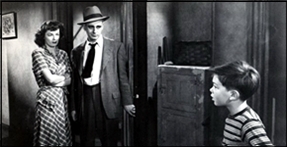Sun 27 Apr 2025
A Movie Review by Jonathan Lewis: THE WINDOW (1949).
Posted by Steve under Crime Films , Reviews[5] Comments

THE WINDOW. RKO Radio Pictures, 1949. Barbara Hale, Arthur Kennedy, Paul Stewart, Ruth Roman, Bobby Driscoll. Based on the story “The Boy Cried Murder” by Cornell Woolrich. Director: Ted Tetzlaff.
Adapted from a short story penned by Cornell Woolrich, The Window is an above average thriller and a suspenseful yarn that holds your attention from beginning to end. With child actor Bobby Driscoll as the glue that holds everything together, the film is never dull or lifeless.

Driscoll, whose adult life was marked by tragedy, portrays Tommy Woodry, an excitable, imaginative young boy living with his working class parents in a modest apartment building in Manhattan. He’s known by both his peers and his parents for telling tall tales, stories about gangsters, Indians, and whatnot. So when he actually does witness a murder, no one believes him. He’s the boy who cried wolf.
Aside from Driscoll, the film benefits from some talented actors. Arthur Kennedy portrays Tommy’s father, a man who is torn between the love he has for his son and his embarrassment at how the boy is seemingly turning into a compulsive liar. The upstairs neighbors, the ones who actually do commit a murder, are portrayed by radio star Paul Stewart and the prolific Ruth Roman. They make a great villainous couple.

There’s a lot to admire in The Window, from the acting to the cinematography and lighting. There’s a shadowy menace to the stairwell in the Woodrys’ apartment building, one that is used to heighten the dangerous situation in which Tommy has found himself. There is also a white knuckle ending that takes place in a nearby condemned building.
This was the second time I’ve had the occasion to watch this movie,and I enjoyed it even more this time. I realized how very much it’s both a Woolrich movie and a New York City one. As much as anything else, this film is about the struggles of postwar life (and death) in the Big Apple.






























